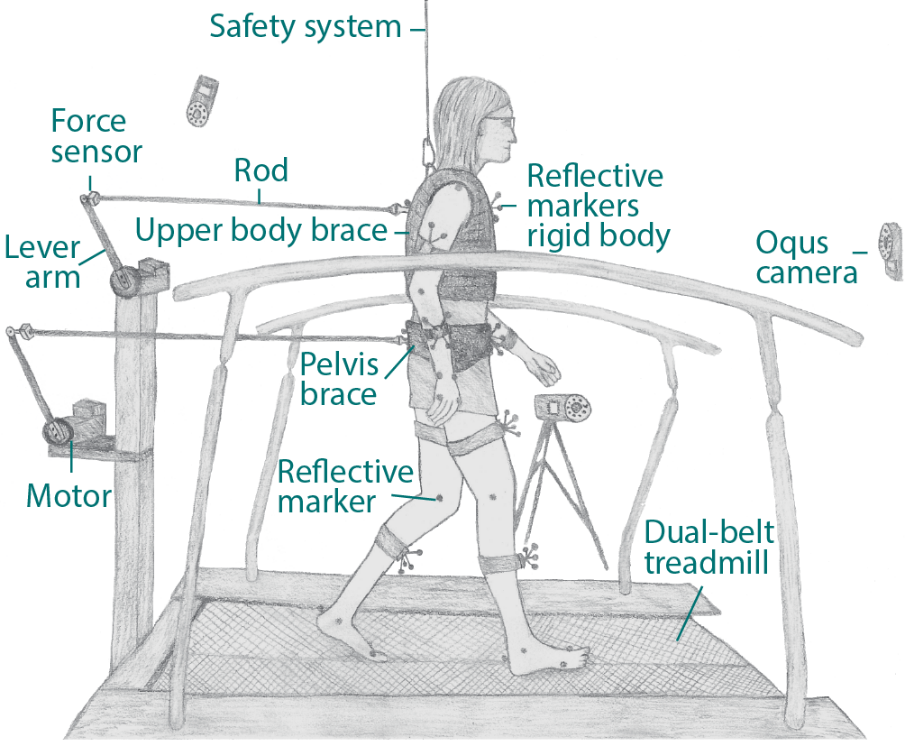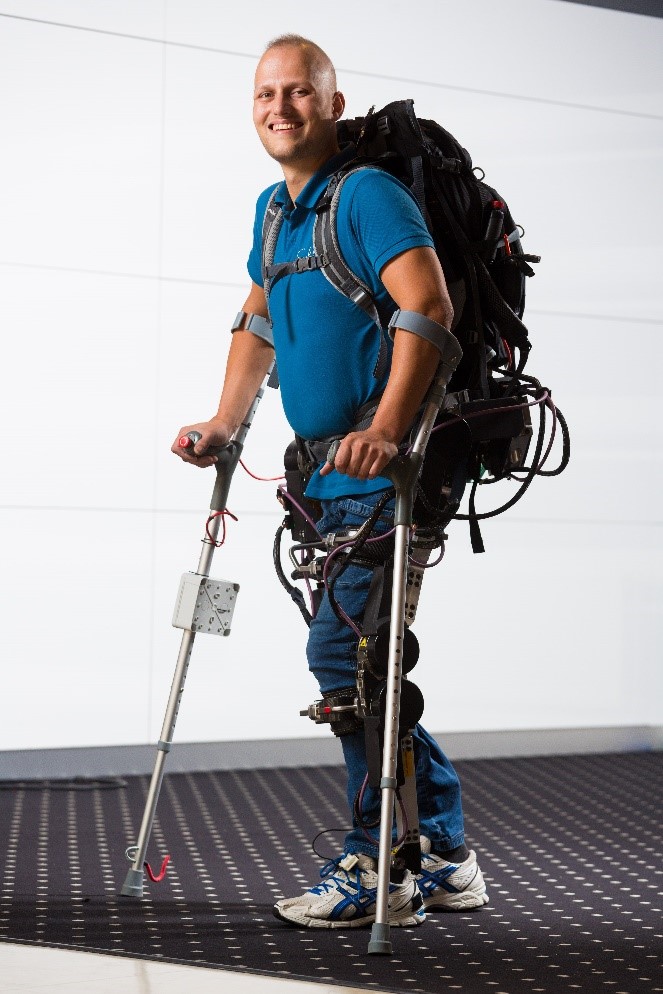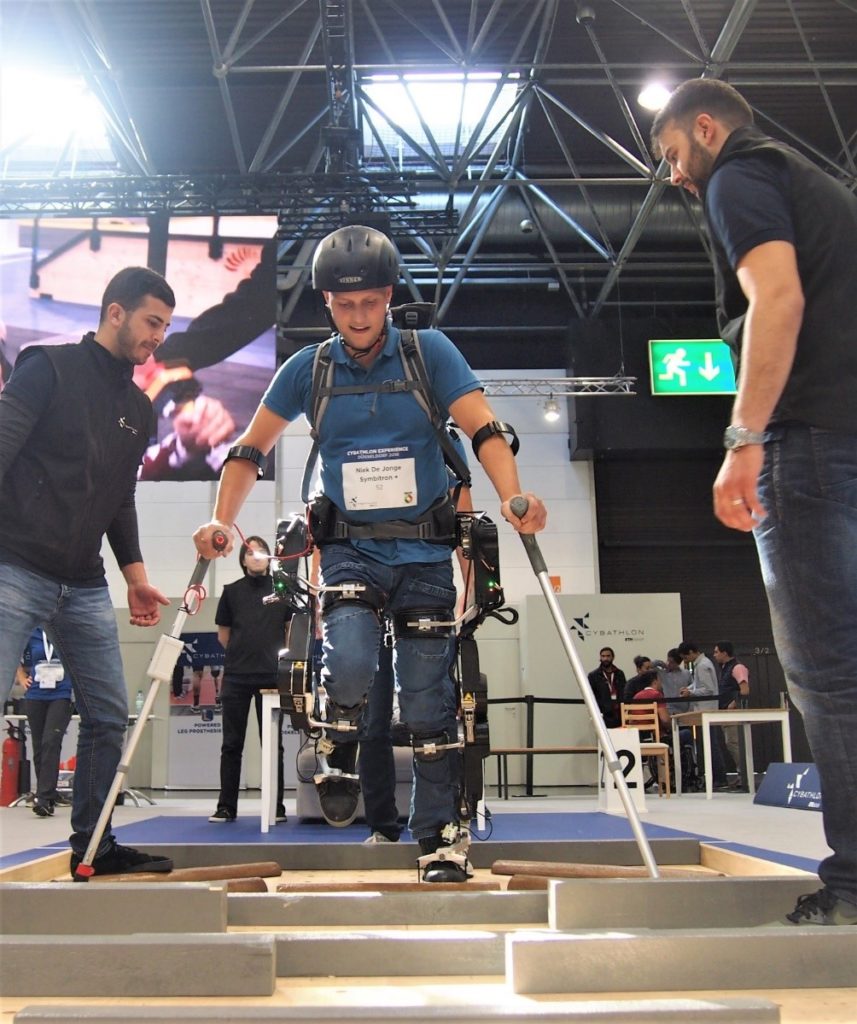Walking has a high priority for recovery among patients with a spinal cord injury, stroke survivors or any patient with motor disorders, irrespective of the severity of injury, time of injury, or age at the time of injury. Lower limb exoskeletons are devices that allow these people to walk again. Walking with an exoskeleton can improve their mobility and independence, and impacts their general health.
Currently, proper balance with exoskeletons is only achieved by the use of crutches. This limits its daily usage to a small range of activities where the use of hands is not needed. The ideal exoskeleton would be the one in which the user can forget they are wearing it, even when doing challenging tasks. Hence, the design of an exoskeleton should incorporate a means of naturally and robustly assisting the user with their balance. This would allow the user to stand and walk without crutches and being able to use their hands for other small actions during daily activities like picking up objects. Additionally, being able to walk on challenging terrains would extend the possibilities of the exoskeleton during daily live activities.
In this project, we focus on developing controllers to assist in balance with exoskeletons during standing and walking. We use insights in human balancing strategies for designing novel control algorithms to ensure that balance is maintained. Additionally, we also focus on safety aspects in case that balance cannot be maintained. That is, looking for safe falling strategies to perform by the exoskeleton and the user in case of a failure of the balance controller.
The assessment of human balance strategies was done in scenarios relevant for walking with an exoskeleton, challenged by external balance perturbation. For example by studying balance strategies at a very slow walking speed, since the current walking speed with an exoskeleton is much lower than a normal walking speed. This also increases the duration of the double support. Healthy individuals are very well capable of recovering balance during this phase. Though, according to simulations even more opportunities are available resulting in a quicker balance recovery. Probably it was not needed to recover that fast, when there is no risk for falling anymore [1]. Also, while standing in a staggered stance (static double support), a coupling was shown between motions in the back-, for- and sideward directions in response to perturbations in different directions [*]. This shows that we should not only take into account responses in the directions of a balance perturbation. A different type of external perturbations were applied as well, inducing a rotation of the upper body. The results showed that humans prioritize recovery of those rotations over perturbations inducing a linear motion of the center of mass [2].

We also initiated development of balance controllers. A popular approach in controlling balance in bipedal robots (humanoids and exoskeletons) is momentum based control. We showed that the strategies that humans use in recovering from balance are similar to the ones that would be predicted using momentum based control. This provides initial evidence that this kind of controller can cooperate with the human inside the exoskeleton to maintain balance [3]. Pilot tests with a healthy and spinal cord injured participant with a momentum based controller in the Symbitron+ exoskeleton during standing showed that the controller indeed is capable of providing the necessary support. More extensive tests on this will be performed soon. Another step that has been made, is the development of a human-inspired cooperative ankle-exoskeleton controller supporting balance during walking. Assessment of this controller by applying external perturbations showed that it assisted in balance recovery of the healthy individuals during walking. The participant reduced their muscle activity while balance performance kept similar [4].


[1] M. van Mierlo, M. Vlutters, E.H.F. van Asseldonk, and H. van der Kooij, “Centre of pressure modulations in double support effectively counteract anteroposterior perturbations during gait”, Journal of Biomechanics, 2021
[2] M. van Mierlo, J.I. Ambrosius, M. Vlutters, E.H.F. van Asseldonk, and H. van der Kooij, “Recovery from whole body angular momentum perturbations during walking”, pre-print: http://ssrn.com/abstract=4059749 , under review at Journal of Biomechanics, 2022
[3] C. Bayón, A.R. Emmens, M. Afschrift, T. van Wouwe, A.Q.L. Keemink, H. van der Kooij, and E.H.F. van Asseldonk, “Can momentum based control predict human balance recovery strategies?”, IEEE Transactions on Neural Systems and Rehabilitation Engineering, 2020
[4] C. Bayón, A.Q.L. Keemink, M. van Mierlo, W. Rampeltshammer, H. van der Kooij, and E.H.F. van Asseldonk, “Cooperative ankle-exoskeleton control can reduce effort to recover balance after unexpected disturbances during walking, 2022
[*] In preparation: M. van Mierlo, J. A. Ormiston, M. Vlutters, E.H.F. van Asseldonk, H. van der Kooij, “Balance response to pelvis perturbations in various directions during staggered stance”, 2022

